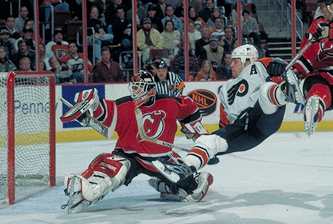|

|
 |
In Goal
 |
| (c) Bruce Bennett Studios |
Every goaltending coach and every goaltender has his own theory on how to play
the breakaway. Regardless of how it is done, the bottom line is to stop the
puck.
Certainly, every goalie will play off his strengths. A goaltender who is good
on dekes will “come out” of his net a little further to take away
any good shots and force a deke. A goaltender weak on dekes will stay back a
bit and take his chances with a shot. Certain goaltenders’ strengths might
include the use of poke checks or stacking pads. Know your strengths and use
them, but also work hard on your weaknesses so they don’t bring you down.
Most coaches use the famous old cliche, “Don’t make the first move!”
It’s not that the goaltender makes the first move, but rather he doesn’t
show enough patience by reacting to the shooter’s first fake. Practice
and “goaltending sense” developed from experience will help goalies
determine the real move from a fake.
These following sections will provide all goaltenders and coaches with some
general mental and physical concepts that should help with many breakaway situations.
Three-Step Approach
Come out extra far: When the goaltender determines there is a breakaway, he
comes out well above the top of the goal crease and gets set. This leaves little
angle for a shot, and forces a sharp player to deke.
Back up: When the player reaches the tops of the circles, the goaltender begins
his backward motion. There are a number of do’s and don’ts, as well
as visual cues to look for.
Save Selection: This is the save choice the goalie makes. Whether it is a stack
of the pads, a half butterfly, or just getting hit in the chest, a decision
based on the situation and visual cues must be made. There are lots of do’s
and don’ts here, too.
Visual Cues & Hints
• Where is the puck being carried by the shooter? If it is in front, a
deke is likely. If it is on the side, there is a good chance the player will
shoot.
• Coming down the wings, be aware that an “off-side wing”
(right hander down the left wing or visa versa) has more angle to shoot than
an “on-side” wing.
• Normally on a deke, the final move will occur after the shooter’s
skates cross the hash marks in the slot. Anything earlier is probably a fake.
• A way to tell the shooter is ready to “make a move” is when
he plants his feet, stops skating and begins to glide. The wider his feet get,
the less options and lateral mobility he has.
• On a deke, players will go to their backhand most often.
• Players will try to get an advantage by using their hands, moving the
puck, head and shoulder fakes, etc. to get the goaltender to move or commit.
While the goaltender must follow the puck, the direction of the players’
chest or midsection can determine to which side the deke will occur. Isn’t
that what defensemen are taught to do?
The Dont's on a Breakaway
• Don’t back in too slow, the player will go around you.
• Don’t back in too fast, the net opens up for a shot.
• Don’t get any deeper than the top of the semi-circular goal crease.
• Don’t stop your backward motion or plant your feet.
• Don’t go for the first fake.
• Don’t lunge forward at the player.
• Don’t overuse the poke check... especially when the player is
coming down the middle.
• Don’t use skate saves too often on dekes. They do not cover a
lot of net.
• Don’t stack your pads parallel to the top of the rectangular crease
when a player is coming down the middle because a big hole opens up between
your hip and elbow.
• If a player dekes to your left, don’t plant your right leg while
you extend your left leg. That opens you up, to easily drive a truck through
your legs.
• Don’t let a player score a goal from inside your goal crease (that’s
your territory).
The Do’s on a Breakaway
• Practice your backward motion timing so the save selection can occur
when you are at the top of the semi-circular goal crease. The backward motion
provides momentum to move to the left or right with a deke.
• Use your stick as an asset, and provide yourself a back-up should you
miss the poke check.
• Show patience by not reacting to the player’s first move... wait
him out for the “real move.” Stay on your feet as long as you can.
• Use pad saves as often as possible on dekes. They cover more net quicker.
• When stacking the pads or using the butterfly on a deke, the goaltender’s
motion should be at a diagonal from the top of the semi-circular crease toward
the outside of the goal post. This eliminates any chance of the player going
around the goaltender. Also, delay the stick movement by keeping it in front
of the goaltender until the hole between the hip and elbow is closed.
• Always make the save! (Easier said than done!)
This first appeared in the 06/1998 issue of Hockey
Player Magazine®
© Copyright 1991-2003, Hockey Player® LLC and Hockey
Player Magazine®
Posted: Nov 6, 2004, 15:39
Top of Page
|
|
 |

|